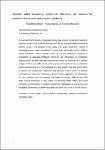Tourists’ selfies storytelling: Preferences, intentions, and concerns for practise in the tourism and hospitality industry
| dc.contributor.author | Elshaer, A | |
| dc.contributor.author | Huang, Rong | |
| dc.contributor.author | Marzouk, A | |
| dc.date.accessioned | 2023-03-30T09:19:16Z | |
| dc.date.issued | 2022-12-18 | |
| dc.identifier.issn | 1356-7667 | |
| dc.identifier.issn | 1479-1870 | |
| dc.identifier.uri | https://pearl.plymouth.ac.uk/handle/10026.1/20643 | |
| dc.description.abstract |
Photography has recently received significant academic interest as a popular tourist activity. However, tourist selfie practises have not yet been thoroughly examined by tourism scholars. This study aimed to investigate tourist selfies storytelling and to determine if tourists'selfies at tourist destinations reveal specific aspects of the host destination, implying an embodiment of particular preferences, intentions, and motivations. In this study, an exploratory analysis employing a two-step qualitative approach was conducted. A semiotic analysis of 317 tourist selfie photos and two phases of in-depth interviews with eleven tourists visiting Egypt on a 7-day packaged tour were used. The findings reveal that tourists prefer to capture host communities’ appearance and attributes in their selfies for different motivations and intentions. Intentions regarding impressions, advertisements, suggestions, and descriptions for these attributes were the intentions that shaped the tourists’ selfie practise. This study contributes to our understanding of the content of travel-related selfies and tourist behaviour at destinations. It proposes management implications to assist tourism and hospitality professionals in engaging with and profiting from tourists’ selfies practise. | |
| dc.format.extent | 135676672211457-135676672211457 | |
| dc.language | en | |
| dc.publisher | SAGE Publications | |
| dc.subject | selfie | |
| dc.subject | tourist behaviour | |
| dc.subject | social media platforms | |
| dc.subject | destinations' marketing | |
| dc.subject | Egypt | |
| dc.title | Tourists’ selfies storytelling: Preferences, intentions, and concerns for practise in the tourism and hospitality industry | |
| dc.type | journal-article | |
| dc.type | Journal Article | |
| plymouth.author-url | https://www.webofscience.com/api/gateway?GWVersion=2&SrcApp=PARTNER_APP&SrcAuth=LinksAMR&KeyUT=WOS:000899749200001&DestLinkType=FullRecord&DestApp=ALL_WOS&UsrCustomerID=11bb513d99f797142bcfeffcc58ea008 | |
| plymouth.publication-status | Published online | |
| plymouth.journal | Journal of Vacation Marketing | |
| dc.identifier.doi | 10.1177/13567667221145712 | |
| plymouth.organisational-group | |Plymouth | |
| plymouth.organisational-group | |Plymouth|Faculty of Arts, Humanities and Business | |
| plymouth.organisational-group | |Plymouth|REF 2021 Researchers by UoA | |
| plymouth.organisational-group | |Plymouth|Users by role | |
| plymouth.organisational-group | |Plymouth|Users by role|Academics | |
| plymouth.organisational-group | |Plymouth|REF 2021 Researchers by UoA|UoA17 Business and Management Studies | |
| plymouth.organisational-group | |Plymouth|Faculty of Arts, Humanities and Business|Plymouth Business School | |
| dcterms.dateAccepted | 2022-01-01 | |
| dc.date.updated | 2023-03-30T09:19:15Z | |
| dc.rights.embargodate | 2023-3-21 | |
| dc.identifier.eissn | 1479-1870 | |
| rioxxterms.versionofrecord | 10.1177/13567667221145712 |


